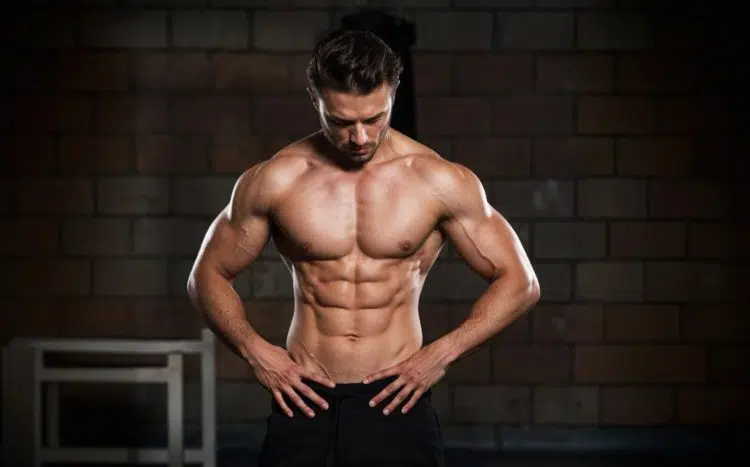Most people have left-to-right imbalances. Some can punch harder with their right arm, while others have a bigger left thigh. Don’t panic; muscle or strength imbalances don’t mean that you are slowly turning into Ephialtes.
However, letting these imbalances run wild can add to the trouble and hamper your overall physique aesthetics, symmetry, balance, and coordination.
As someone who has been training for the last 17 years, I recently started noticing significant imbalances between my sides. My left bicep, forearm, thigh, and calf were noticeably lagging compared to my dominant side.
Contrary to what most people think, the side effects of imbalances aren’t limited to aesthetics; they affect your overall performance. Research suggests that non-dominant side training can be an effective way to improve overall balance and coordination. (1)
Recently, I decided to iron out my left-to-right imbalances once and for all and undertook a 30-day challenge wherein I only trained my non-dominant side. In this article, I share my experience and results of training my lagging side exclusively for a month.
Non-Dominant Side Workouts
Level Up Your Fitness: Join our 💪 strong community in Fitness Volt Newsletter. Get daily inspiration, expert-backed workouts, nutrition tips, the latest in strength sports, and the support you need to reach your goals. Subscribe for free!
Designing a non-dominant side-focused workout program is relatively straightforward. You only perform unilateral exercises that allow you to train one side at a time. However, execution is where it makes a difference. Below is a sample unilateral workout for each muscle group:
Chest
I opened this training program with a chest workout. Let me tell you this: training one side of the chest at a time is very challenging and requires some getting used to. I recommend holding onto a dumbbell in the non-working hand for counterbalance.
| Exercises | Sets | Reps |
| Single-arm dumbbell press | 3 | 8-12 |
| Unilateral cable flyes | 3 | 8-12 |
| Single-arm machine chest press | 3 | 8-12 |
| Single-arm incline dumbbell press | 3 | 8-12 |
| One-arm push-ups (Advanced) | 3 | 8-12 |
Back
Prioritize contracting the target muscles with each rep. This will deepen the mind-muscle connection, leading to greater stimulation and growth.
| Exercises | Sets | Reps |
| Single-arm dumbbell row | 3 | 8-12 |
| One-arm lat pull-down | 3 | 8-12 |
| Single-arm cable row | 3 | 8-12 |
| Unilateral chest-supported row | 3 | 8-12 |
| Single-arm straight-arm lat pulldown | 3 | 8-12 |
Core
I didn’t want to leave out any muscle group. My ab workouts included anti-rotations, flexion, and extension exercises to ensure overall development. I performed this ab workout thrice weekly at the end of each strength training session.
| Exercises | Sets | Reps |
| Side planks | 3 | 8-12 |
| Palloff press | 3 | 8-12 |
| Russian Twists | 3 | 8-12 |
Arms
Training a weaker limb can be the most challenging, as it is usually the root cause behind most left-to-right muscle imbalances. I recommend my clients employ slow eccentrics to increase the time under tension (TUT) and maximize target muscle fiber activation and growth. (2)
| Exercises | Sets | Reps |
| Single-arm dumbbell curl | 3 | 8-12 |
| Unilateral preacher curl | 3 | 8-12 |
| Single-arm cable curl | 3 | 8-12 |
| One-arm cable pushdown | 3 | 8-12 |
| Single-arm overhead cable tricep extension | 3 | 8-12 |
| Unilateral wrist curl | 3 | 8-12 |
Shoulders
Single-arm shoulder exercises require significant core stabilizer strength. Use challenging weights, but focus on keeping your torso upright throughout the exercises to avoid unnecessary muscle strains.
| Exercises | Sets | Reps |
| Single-arm dumbbell shoulder press | 3 | 8-12 |
| Single-arm lateral raise | 3 | 8-12 |
| Unilateral dumbbell upright row | 3 | 8-12 |
| One-arm shrug | 3 | 8-12 |
| Single-arm front raise | 3 | 8-12 |
Legs
I prefer machines for unilateral leg training, as they eliminate the need to stabilize the weight, which can promote the mind-muscle connection. Employ a full range of motion (ROM) with each rep to ensure optimal target muscle activation.
| Exercises | Sets | Reps |
| Unilateral leg press | 3 | 8-12 |
| Single-leg extension | 3 | 8-12 |
| Single-leg curl | 3 | 8-12 |
| Single-leg RDLs | 3 | 8-12 |
| One-leg calf raise | 3 | 8-12 |
With this, you have enough gunpowder to fix any and all muscle and strength imbalances.
How To Schedule & Track
Here is a lowdown on how to program and track a workout focused on your non-dominant side:
Frequency & Duration
Since this is only a four-week challenge, you don’t need a ton of exercise variations to get the best bang for your buck. If you follow the five-day-a-week training program listed above, you will only have four attempts at these workouts.
I highly recommend getting accustomed to the movement mechanics of each exercise in the first week and using the remaining three weeks to overload the muscles to maximize stimulation and growth.
The exact training volume, intensity, and duration of your workouts will depend on your lifting experience and goals. Beginners should seek expert guidance to devise an optimal training regime.
Tracking
Remember, what gets tracked gets improved. You must maintain detailed notes of the exercise, sets, reps, and weights during each workout. This will help ensure you are employing progressive overload for consistent progress.
Regular progress photos and body circumference measurements will keep you accountable and ensure you are moving in the right direction.
Level Up Your Fitness: Join our 💪 strong community in Fitness Volt Newsletter. Get daily inspiration, expert-backed workouts, nutrition tips, the latest in strength sports, and the support you need to reach your goals. Subscribe for free!
Weekly Summary of Training Non-Dominant Side For 30 Days
Read about my experience with this four-week challenge:
Week One: Struggles and Adaptations
Honestly, I initially took this training program too lightly. I had thought that training one side at a time would be easier. However, since the goal here is to lift the same amount of weight as you do on your stronger side, you have to work extra hard to complete the same number of reps.
Furthermore, since you are only working one side at a time, you don’t get the rest time between reps you typically get with bilateral exercises.
Weeks Two and Three: Progress and Plateaus
Training one side at a time can be extremely mentally fatiguing. There were times when I started alternating between sides during exercises like dumbbell curls due to muscle memory. This training protocol demands mental focus and concentration. That said, this can be a blessing in disguise as it can help improve the coveted mind-muscle connection.
I struggled with exercises like the unilateral leg press and shoulder press in Week Two and employed advanced training techniques like dropsets and negatives to break through the wall in the third week.
Week Four: The Final Push
The final week was when it all started to click, and the progress of my non-dominant side picked up. The strength and muscle gains on my lagging side were noticeable, which helped improve my overall coordination, muscle symmetry and balance, and overall performance.
Results of Training My Lagging Side For 30-Day Straight
Let’s cut to the chase and talk about the results I got from this radical training program. Here are my before and after numbers:
| Body Part | Before (inches) | After (inches) |
| Right Bicep | 14.5 | 14.5 |
| Left Bicep | 13 | 13.75 |
| Right Forearm | 11 | 11 |
| Left Forearm | 10 | 10.5 |
| Right Thigh | 23 | 23 |
| Left Thigh | 22 | 22.5 |
| Right Calf | 15 | 15 |
| Left Calf | 14.5 | 15 |
While I couldn’t bring all my muscles up to power with the stronger side, the progress was undeniable.
While I won’t be sticking to exclusive workouts for the non-dominant side, I will definitely be making certain changes to my typical training routine to further improve my overall physique symmetry and balance. For example, I am doing an additional three to five reps on the weaker side during each unilateral exercise for greater stimulation.
Improvements in Coordination and Balance
After 30 days, the unilateral exercises on the lagging side didn’t feel as challenging as they did in the first week. My left side was starting to hold its own in almost every exercise.
Plus, working one side at a time improved my hand-eye coordination and balance. Have you tried bruising your teeth with your non-dominant hand? I did, and it was wobbly, and I hurt my gums. However, focusing on my weaker side enhanced my coordination and control, making brushing and several other everyday tasks like balancing on one leg much easier.
Training the non-dominant side exclusively for a certain period can also be very rewarding for athletes who want to boost their overall performance. Tennis, badminton, rugby, hockey, and basketball athletes can benefit from bringing up their lagging sides.
Science Behind the Results
The fitness world is full of fads. However, non-dominant side training isn’t one of them.
Training the non-dominant side can reinforce neural pathways, making them more efficient. This is mainly due to brain plasticity — your brain’s ability to adapt and change to new conditions. The more you work with your lagging side, the better your control, coordination, balance, and even cognitive function.
A study suggests that using your non-dominant side can lead to various cognitive benefits, including reduced depression symptoms, increased self-control, lower levels of stress, and improved creative thinking. (3)
Benefits of Non-Dominant Side Training For Injury Prevention and Performance
Widening muscle imbalances increase your risk of injuries during training and everyday functioning. Focusing on the non-dominant side promotes a more symmetrical, balanced physique. This can boost your overall athletic performance by improving power generation and agility.
A balanced physique ensures your muscles, joints, tendons, and ligaments are working in harmony. Fixing imbalances significantly limits the occurrence of nagging aches and pains. Plus, improved coordination and balance mean you’re less likely to stumble, trip, or fall. This is a win-win on all fronts.
Conclusion
Irrespective of how severe your muscle and strength imbalances are, you must work on them to bridge the gap and avoid future injuries or performance setbacks. The five-day workout listed in this article is suitable for athletes of all experience levels and will help improve coordination, balance, and overall symmetry.
Training the non-dominant side exclusively can be challenging initially, but you must stick with it for at least four to eight weeks to achieve the desirable results. If you are dealing with an imbalance, I encourage you to take up this 30-day challenge to experience its benefits firsthand.
If you have any questions about designing or implementing a non-dominant side-focused workout program, post them in the comments below, and I’ll be happy to help!
References:
- Ridding, M. C., & Flavel, S. C. (2006). Induction of plasticity in the dominant and non-dominant motor cortices of humans. Experimental brain research, 171(4), 551–557. https://doi.org/10.1007/s00221-005-0309-2
- Burd NA, Andrews RJ, West DW, et al. Muscle time under tension during resistance exercise stimulates differential muscle protein sub-fractional synthetic responses in men. J Physiol. 2012;590(2):351-362. doi:10.1113/jphysiol.2011.221200
- Goddard, Louise. How Using Your Non-Dominant Hand Can Benefit You. https://www.researchgate.net/publication/378263522_How_Using_Your_Non-Dominant_Hand_Can_Benefit_You (accessed August 14, 2024)











